Analysis of the Coupling Characteristics of Water Resources and Food Security: The Case of Northwest China
Abstract
:1. Introduction
2. Materials and Methods
2.1. Overview of the Study Area
2.2. Data Sources
2.3. Methods
2.3.1. Water-Resource Load Index
2.3.2. Water Footprint of Grain Production
2.3.3. Water Footprint of Grain Consumption
3. Results
3.1. Impact of Water-Supply Capacity on Food Security
3.1.1. Spatial- and Temporal-Distribution Characteristics of Water Resources
3.1.2. Analysis of Water-Resource Development Potential
3.1.3. Spatial and Temporal Characteristics of Water-Use Structure
3.2. Relationship between Water-Resource Demand and Food Security
3.2.1. Effect of Dietary-Structure Change on Water-Resource Demand
3.2.2. Impact of Population Urbanization on Water-Resource Demand
3.2.3. Impact of Industrial Consumption on Water-Resource Demand
4. Discussion
4.1. Water Resources and Food Security Will Likely Face Greater Challenges in the Future
4.2. Measures to Effectively Reduce the Water Footprint of Crop Production and Water-Consumption Footprint
5. Conclusions
Author Contributions
Funding
Institutional Review Board Statement
Informed Consent Statement
Data Availability Statement
Conflicts of Interest
References
- Liu, X.; Xu, Y.; Engel, B.A.; Sun, S.; Zhao, X.; Wu, P.; Wang, Y. The impact of urbanization and aging on food security in developing countries: The view from Northwest China. J. Clean. Prod. 2021, 292, 126067. [Google Scholar] [CrossRef]
- Zhang, Z.; Duan, Z.; Chen, Z.; Xu, P.; Li, G. Food security of China: The past, present and future. Plant Omics 2010, 3, 183. [Google Scholar]
- Liu, X.; Shi, L.; Qian, H.; Sun, S.; Wu, P.; Zhao, X.; Engel, B.A.; Wang, Y. New problems of food security in Northwest China: A sustainability perspective. Land Degrad. Dev. 2020, 31, 975–989. [Google Scholar] [CrossRef]
- Zhang, H.; Li, M. China’s water diplomacy in the Mekong: A paradigm shift and the role of Yunnan provincial government. Water Int. 2020, 45, 4–347. [Google Scholar] [CrossRef]
- Chartres, C.J.; Noble, A. Sustainable intensification: Overcoming land and water constraints on food production. Food Secur. 2015, 7, 235–245. [Google Scholar] [CrossRef]
- Jiang, Y.; Cai, W.; Du, P.; Pan, W.; Wang, C. Virtual water in interprovincial trade with implications for China’s water policy. J. Clean. Prod. 2015, 87, 655–665. [Google Scholar] [CrossRef]
- Liu, X.; Shi, L.; Engel, B.A.; Sun, S.; Wang, Y. New challenges of food security in Northwest China: Water footprint and virtual water perspective. J. Clean. Prod. 2019, 245, 118939. [Google Scholar] [CrossRef]
- Qin, S.; Li, S.; Kang, S.; Du, T.; Tong, L.; Ding, R. Can the drip irrigation under film mulch reduce crop evapotranspiration and save water under the sufficient irrigation condition? Agric. Water Manag. 2016, 177, 128–137. [Google Scholar] [CrossRef]
- Lu, J.; Ma, L.; Hu, T.; Geng, C.; Yan, S. Deficit drip irrigation based on crop evapotranspiration and precipitation forecast improves water-use efficiency and grain yield of summer maize. J. Sci. Food Agric. 2022, 102, 653–663. [Google Scholar] [CrossRef]
- Amare, D. Review on Effect of Different Irrigation Method on Water Use Efficiency, Yield Productivity and Nitrogen Application. J. Biol. Agric. Healthc. 2020, 10, 1–9. [Google Scholar]
- Li, J.; Xu, X.; Lin, G.; Wang, Y.; Liu, Y.; Zhang, M.; Zhou, J.; Wang, Z.; Zhang, Y. Micro-irrigation improves grain yield and resource use efficiency by co-locating the roots and N-fertilizer distribution of winter wheat in the North China Plain. Sci. Total Environ. 2018, 643, 367–377. [Google Scholar] [CrossRef] [PubMed]
- Kang, S.; Zhang, L.; Trout, T. Special Issue: Improving Agricultural Water Productivity to Ensure Food Security under Changing Environments. Agric. Water Manag. 2017, 179, 1–4. [Google Scholar] [CrossRef]
- Cheng, M.; Wang, H.; Fan, J.; Zhang, S.; Liao, Z.; Zhang, F.; Wang, Y. A global meta-analysis of yield and water use efficiency of crops, vegetables and fruits under full, deficit and alternate partial root-zone irrigation. Agric. Water Manag. 2021, 248, 106771. [Google Scholar] [CrossRef]
- Cheng, M.; Wang, H.; Fan, J.; Zhang, F.; Wang, X. Effects of soil water deficit at different growth stages on maize growth, yield, and water use efficiency under alternate partial root-zone irrigation. Water 2021, 13, 148. [Google Scholar] [CrossRef]
- Du, T.; Kang, S.; Zhang, J.; Davies, W. Deficit irrigation and sustainable water-resource strategies in agriculture for China’s food security. J. Exp. Bot. 2015, 66, 2253–2269. [Google Scholar] [CrossRef]
- Tong, X.; Wu, P.; Liu, X.; Zhang, L.; Zhou, W.; Wang, Z. A global meta-analysis of fruit tree yield and water use efficiency under deficit irrigation. Agric. Water Manag. 2022, 260, 107321. [Google Scholar] [CrossRef]
- Xu, Y.; Wang, Y.; Ma, X.; Liu, X.; Jia, Z. Ridge-furrow mulching system and supplementary irrigation can reduce the greenhouse gas emission intensity. Sci. Total Environ. 2020, 717, 137262. [Google Scholar] [CrossRef]
- Wang, J.; Zhang, S.; Sainju, U.M.; Ghimire, R.; Zhao, F. A meta-analysis on cover crop impact on soil water storage, succeeding crop yield, and water-use efficiency. Agric. Water Manag. 2021, 256, 107085. [Google Scholar] [CrossRef]
- Farooq, M.; Hussain, M.; Ul-Allah, S.; Siddique, K.H. Physiological and agronomic approaches for improving water-use efficiency in crop plants. Agric. Water Manag. 2019, 219, 95–108. [Google Scholar] [CrossRef]
- Leal Filho, W.; de Trincheria Gomez, J. Preface: Rainwater-Smart Agriculture in Arid and Semi-Arid Areas; Springer: Berlin/Heidelberg, Germany, 2018; pp. 1–5. [Google Scholar]
- Damerau, K.; Waha, K.; Herrero, M. The impact of nutrient-rich food choices on agricultural water-use efficiency. Nat. Sustain. 2019, 2, 233–241. [Google Scholar] [CrossRef]
- Wang, J.; Sun, S.; Yin, Y.; Wang, K.; Sun, J.; Tang, Y.; Zhao, J. Water-Food-Carbon Nexus from Producer-Consumer Link: A Review. Adv. Nutr. 2022, 13, 938–952. [Google Scholar] [CrossRef] [PubMed]
- Duan, W.; Chen, Y.; Zou, S.; Nover, D. Managing the water-climate- food nexus for sustainable development in Turkmenistan. J. Clean. Prod. 2019, 220, 212–224. [Google Scholar] [CrossRef]
- Kirby, M.; Ahmad, M.U.D. Can Pakistan achieve sustainable water security? Climate change, population growth and development impacts to 2100. Sustain. Sci. 2022, 1–14. [Google Scholar] [CrossRef]
- Abbas, S.; Kousar, S.; Khan, M.S. The role of climate change in food security; empirical evidence over Punjab regions, Pakistan. Environ. Sci. Pollut. Res. 2022, 1–19. [Google Scholar] [CrossRef] [PubMed]
- Jalava, M.; Guillaume, J.H.A.; Kummu, M.; Porkka, M.; Siebert, S.; Varis, O. Diet change and food loss reduction: What is their combined impact on global water use and scarcity? Earth’s Future 2016, 4, 62–78. [Google Scholar] [CrossRef] [Green Version]
- Sun, M.; Niu, W.; Zhang, B.; Geng, Q.; Yu, Q. Spatial-temporal evolution pattern and response of ecosystem service value under land use change in the Yellow River Basin: A case study of Shaanxi-Gansu-Ningxia region, Northwest China. Chin. J. Appl. Ecol. 2021, 1–11. [Google Scholar] [CrossRef]
- NBS. National Bureau of Statistics, China Statistical Yearbook; National Bureau of Statistics (NBS): Beijing, China, 2021.
- CMDC. China Meteorological Data Service Center; CMDC: Beijing, China, 2000–2020. [Google Scholar]
- Wu, D.; Shen, Y.J.Y.W.H. Analysis of the Break-even and Load Index of Water Resources in Beijing. In Proceedings of the 1st International Symposium on Innovative Management and Economics (ISIME 2021), Moscow, Russia, 2–3 June 2021; Atlantis Press: Paris, France, 2021; pp. 584–590. [Google Scholar]
- Xia, F.; Chen, Y.; Dou, M.; Han, Y. Calculation method and application of spatial equilibrium coefficient of water resources. Water Resour. Prot. 2020, 36, 52–57. [Google Scholar]
- Luan, X.; Wu, P.; Sun, S.; Wang, Y.; Gao, X. Quantitative study of the crop production water footprint using the SWAT model. Ecol. Indic. 2018, 89, 1–10. [Google Scholar] [CrossRef]
- Döll, P.; Siebert, S. Global modeling of irrigation water requirements. Water Resour. Res. 2002, 38, 8-1–8-10. [Google Scholar] [CrossRef]
- Sun, S.K.; Yin, Y.L.; Wu, P.T.; Wang, Y.B.; Luan, X.B.; Li, C. Geographical Evolution of Agricultural Production in China and Its Effects on Water Stress, Economy and the Environment: The Virtual Water Perspective. Water Resour. Res. 2019, 55, 4014–4029. [Google Scholar] [CrossRef]
- Hoekstra, A.Y.; Chapagain, A.K.; Aldaya, M.M.; Mekonnen, M.M. The Water Footprint Assessment Manual: Setting the Global Standard; Routledge: London, UK; Washington, DC, USA, 2011. [Google Scholar]
- Xu, Z.; Zhang, W.; Li, M. China’s grain production. Mon. Rev. 2014, 66, 25–37. [Google Scholar] [CrossRef]
- Yang, M.Z.; Pei, Y.S.; Li, X.D. Study on grain self-sufficiency rate in China: An analysis of grain, cereal grain and edible grain. J. Nat. Resour. 2019, 34, 881–889. [Google Scholar] [CrossRef]
- Wang, L.; Xiao, Y.; Ouyang, Z. Food and Grain Consumption Per Capita in the Qinghai–Tibet Plateau and Implications for Conservation. Nutrients 2021, 13, 3742. [Google Scholar] [CrossRef]
- Tang, H.J.; Li, Z. Study on per capita grain demand based on chinese reasonable dietary pattern. Sci. Agric. Sin. 2012, 45, 2315–2327. [Google Scholar]
- United Nations. Department of Economic and Social Affairs Population Dynamics, World Population Prospects 2019. Available online: https://population.un.org/wpp/Download/Standard/Population/ (accessed on 1 January 2021).
- Devkota, K.P.; Khanda, C.M.; Beebout, S.J.; Mohapatra, B.K.; Singleton, G.R.; Puskur, R. Assessing alternative crop establishment methods with a sustainability lens in rice production systems of Eastern India. J. Clean. Prod. 2020, 244, 118835. [Google Scholar] [CrossRef]
- Zhang, W.; Dong, A.; Liu, F.; Niu, W.; Siddique, K.H.M. Effect of film mulching on crop yield and water use efficiency in drip irrigation systems: A meta-analysis. Soil Tillage Res. 2022, 221, 105392. [Google Scholar] [CrossRef]
- Li, J.; Luo, G.; Shaibu, A.S.; Li, B.; Zhang, S.; Sun, J. Optimal fertilization level for yield, biological and quality traits of soybean under drip irrigation system in the arid region of Northwest China. Agronomy 2022, 12, 291. [Google Scholar] [CrossRef]
- Zhu, Y.; Cai, H.; Song, L.; Wang, X.; Shang, Z.; Sun, Y. Aerated irrigation of different irrigation levels and subsurface dripper depths affects fruit yield, quality and water use efficiency of greenhouse tomato. Sustainability 2020, 12, 2703. [Google Scholar] [CrossRef] [Green Version]
- Isla, R.; Valentín-Madrona, F.; Maturano, M.; Aibar, J.; Guillén, M.; Quílez, D. Comparison of different approaches for optimizing nitrogen management in sprinkler-irrigated maize. Eur. J. Agron. 2020, 116, 126043. [Google Scholar] [CrossRef]
- Zapata, N.; Robles, O.; Playán, E.; Paniagua, P.; Romano, C.; Salvador, R.; Montoya, F. Low-pressure sprinkler irrigation in maize: Differences in water distribution above and below the crop canopy. Agric. Water Manag. 2018, 203, 353–365. [Google Scholar] [CrossRef]
- Ma, X.; Sanguinet, K.A.; Jacoby, P.W. Direct root-zone irrigation outperforms surface drip irrigation for grape yield and crop water use efficiency while restricting root growth. Agric. Water Manag. 2020, 231, 105993. [Google Scholar] [CrossRef]
- Yu, L.; Zhao, X.; Gao, X.; Siddique, K.H. Improving/maintaining water-use efficiency and yield of wheat by deficit irrigation: A global meta-analysis. Agric. Water Manag. 2020, 228, 105906. [Google Scholar] [CrossRef]
- Zhang, J.; Ji, J.; Wang, P.; Long, H.; Wu, X. Molecular mechanism of negative pressure irrigation inhibiting root growth and improving water use efficiency in maize. Plant Soil 2022, 472, 127–143. [Google Scholar] [CrossRef]
- Cheng, D.; Wang, Z.; Yang, L.; Zhang, L.; Zhang, Q. Combined effects of mulching and crop density on soil evaporation, temperature, and water use efficiency of winter wheat. Exp. Agric. 2021, 57, 163–174. [Google Scholar] [CrossRef]
- Liang, J.; He, Z.; Shi, W. Cotton/mung bean intercropping improves crop productivity, water use efficiency, nitrogen uptake, and economic benefits in the arid area of Northwest China. Agric. Water Manag. 2020, 240, 106277. [Google Scholar] [CrossRef]
- Li, Y.; Tian, D.; Feng, G.; Yang, W.; Feng, L. Climate change and cover crop effects on water use efficiency of a corn-soybean rotation system. Agric. Water Manag. 2021, 255, 107042. [Google Scholar] [CrossRef]
- Gao, Y.; Shao, G.; Lu, J.; Zhang, K.; Wu, S.; Wang, Z. Effects of biochar application on crop water use efficiency depend on experimental conditions: A meta-analysis. Field Crops Res. 2020, 249, 107763. [Google Scholar] [CrossRef]
- Wu, W.; Han, J.; Gu, Y.; Li, T.; Xu, X.; Jiang, Y.; Cheng, K. Impact of biochar amendment on soil hydrological properties and crop water use efficiency: A global meta-analysis and structural equation model. GCB Bioenergy 2022, 14, 657–668. [Google Scholar] [CrossRef]
- Bi, J.; Hou, D.; Zhang, X.; Tan, J.; Bi, Q.; Zhang, K.; Luo, L. A novel water-saving and drought-resistance rice variety promotes phosphorus absorption through root secreting organic acid compounds to stabilize yield under water-saving condition. J. Clean. Prod. 2021, 315, 127992. [Google Scholar] [CrossRef]
- Oguge, N.; Oremo, F. Fostering the use of rainwater for off-season small-scale irrigation in arid and semi-arid areas of Kenya. In Rainwater-Smart Agriculture in Arid and Semi-Arid Areas; Springer: Berlin/Heidelberg, Germany, 2018; pp. 159–174. [Google Scholar]
- Guo, L.; Ning, T.; Nie, L.; Li, Z.; Lal, R. Interaction of deep placed controlled-release urea and water retention agent on nitrogen and water use and maize yield. Eur. J. Agron. 2016, 75, 118–129. [Google Scholar] [CrossRef]
- Chen, C.; Wang, X.; Chen, H.; Wu, C.; Mafarja, M.; Turabieh, H. Towards Precision Fertilization: Multi-Strategy Grey Wolf Optimizer Based Model Evaluation and Yield Estimation. Electronics 2021, 10, 2183. [Google Scholar] [CrossRef]
- Muneret, L.; Mitchell, M.; Seufert, V.; Aviron, S.; Pétillon, J.; Plantegenest, M.; Thiéry, D.; Rusch, A. Evidence that organic farming promotes pest control. Nat. Sustain. 2018, 1, 361–368. [Google Scholar] [CrossRef]
- Rose, D.; Willits-Smith, A.M.; Heller, M.C. Single-item substitutions can substantially reduce the carbon and water scarcity footprints of US diets. Am. J. Clin. Nutr. 2022, 115, 378–387. [Google Scholar] [CrossRef] [PubMed]
- Tompa, O.; Kiss, A.; Maillot, M.; Sarkadi Nagy, E.; Temesi, Á.; Lakner, Z. Sustainable Diet Optimization Targeting Dietary Water Footprint Reduction-A Country-Specific Study. Sustainability 2022, 14, 2309. [Google Scholar] [CrossRef]
- Mirzaie-Nodoushan, F.; Morid, S.; Dehghanisanij, H. Reducing water footprints through healthy and reasonable changes in diet and imported products. Sustain. Prod. Consum. 2020, 23, 30–41. [Google Scholar] [CrossRef]
- Sobhani, S.R.; Rezazadeh, A.; Omidvar, N.; Eini-Zinab, H. Healthy diet: A step toward a sustainable diet by reducing water footprint. J. Sci. Food Agric. 2019, 99, 3769–3775. [Google Scholar] [CrossRef]
- Liu, W.; Yang, H.; Liu, Y.; Kummu, M.; Hoekstra, A.Y.; Liu, J.; Schulin, R. Water resources conservation and nitrogen pollution reduction under global food trade and agricultural intensification. Sci. Total Environ. 2018, 633, 1591–1601. [Google Scholar] [CrossRef] [Green Version]
- Delbourg, E.; Dinar, S. The globalization of virtual water flows: Explaining trade patterns of a scarce resource. World Dev. 2020, 131, 104917. [Google Scholar] [CrossRef]
- Liu, W.; Antonelli, M.; Kummu, M.; Zhao, X.; Wu, P.; Liu, J.; Yang, H. Savings and losses of global water resources in food-related virtual water trade. Wiley Interdiscip. Rev.: Water 2019, 6, e1320. [Google Scholar] [CrossRef] [Green Version]

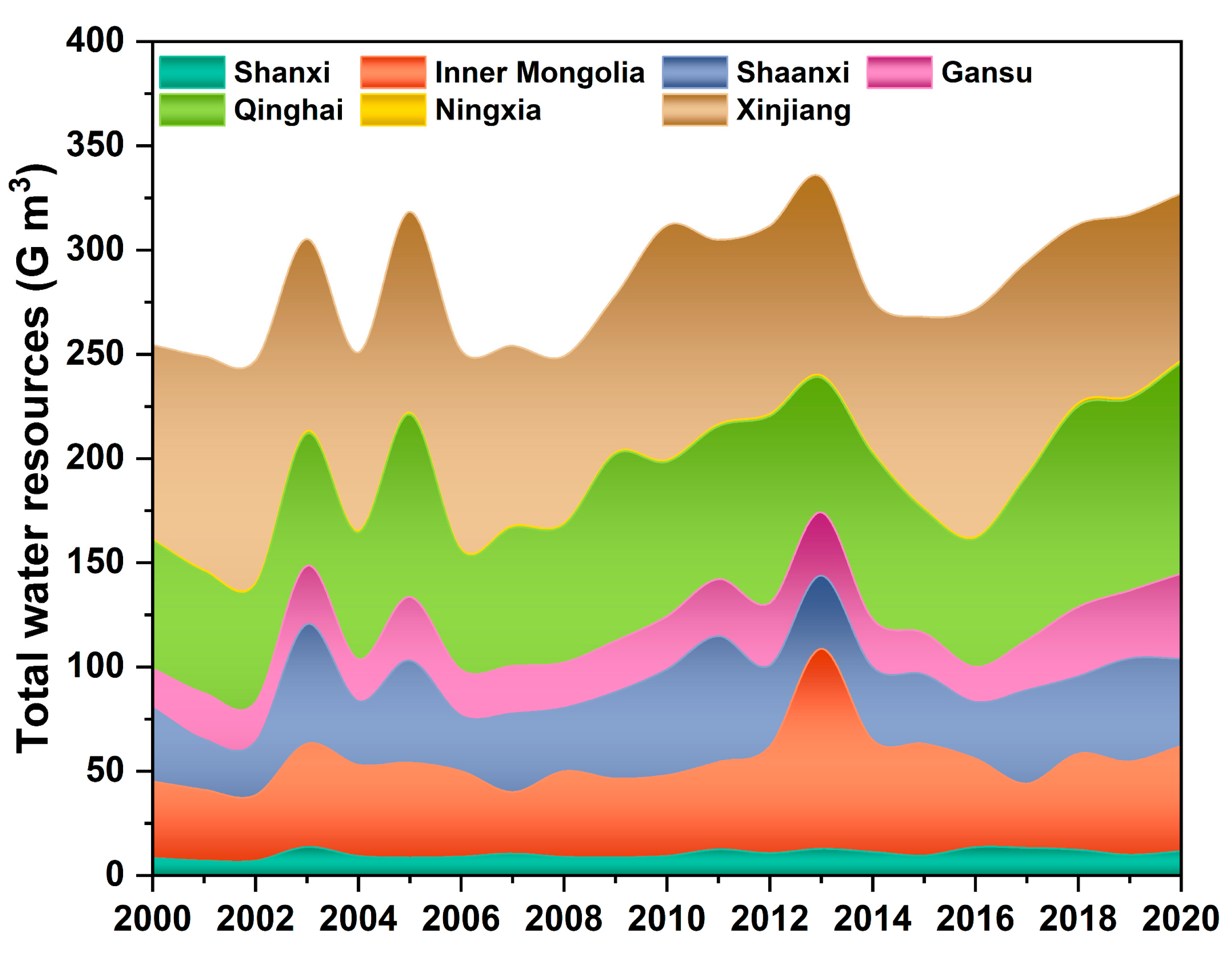
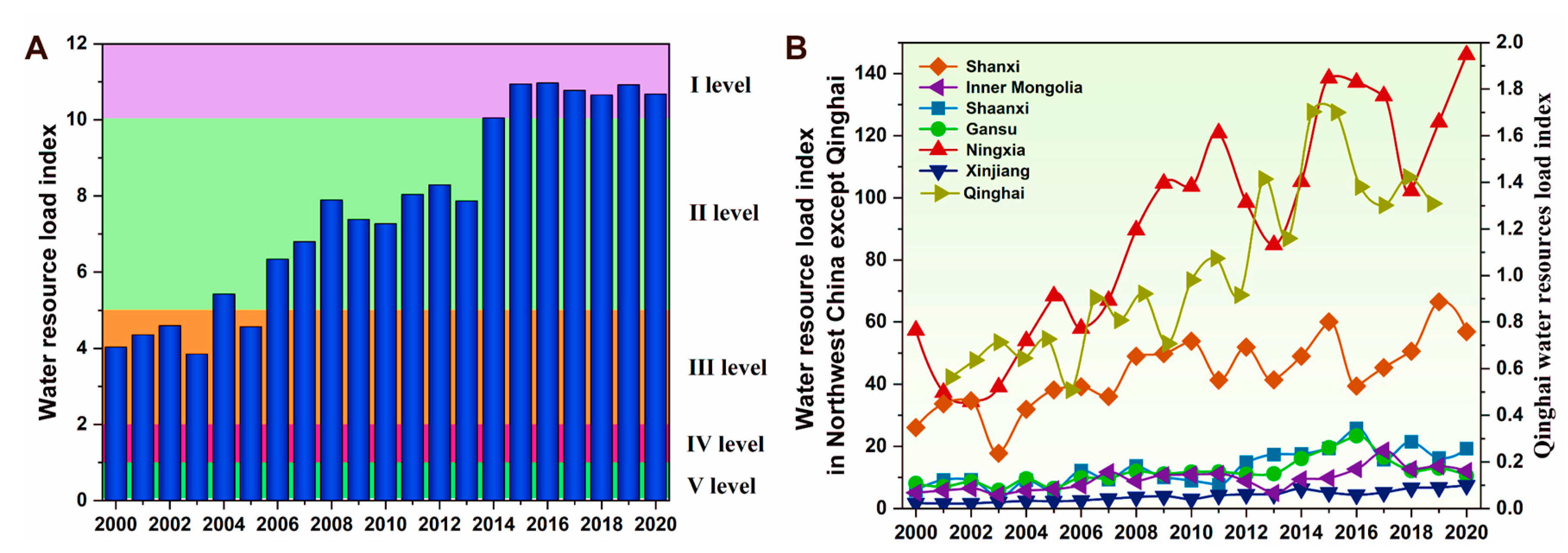

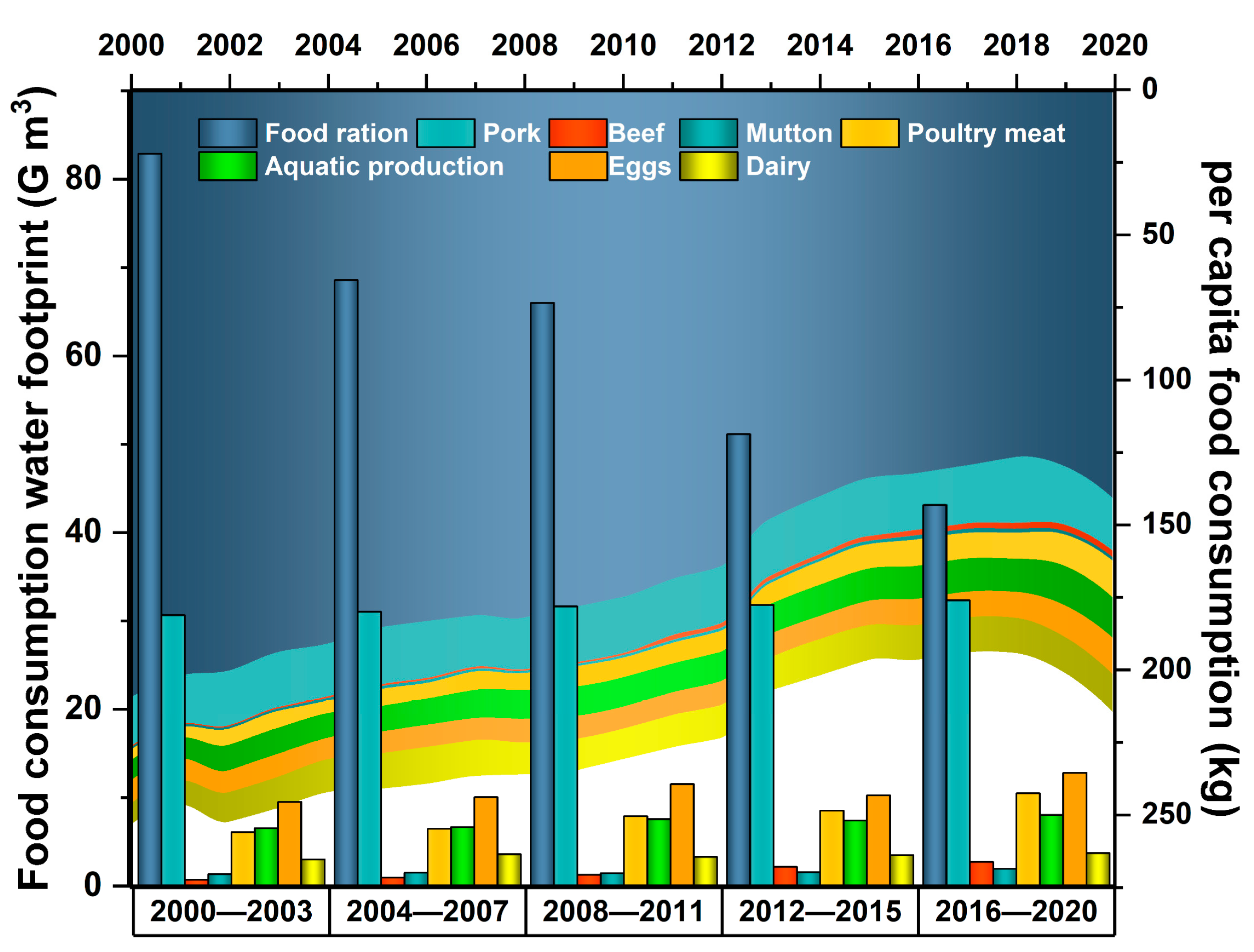
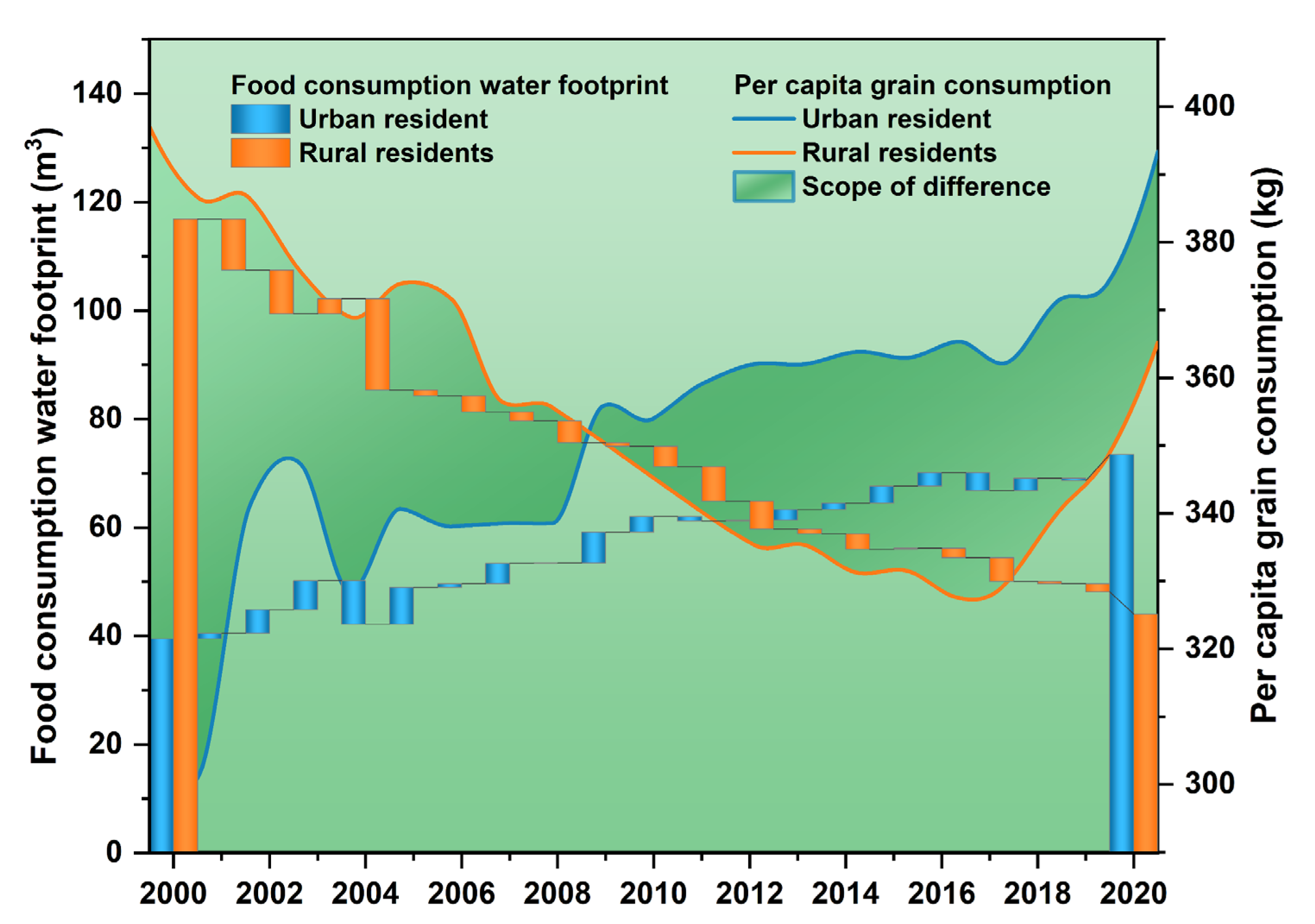
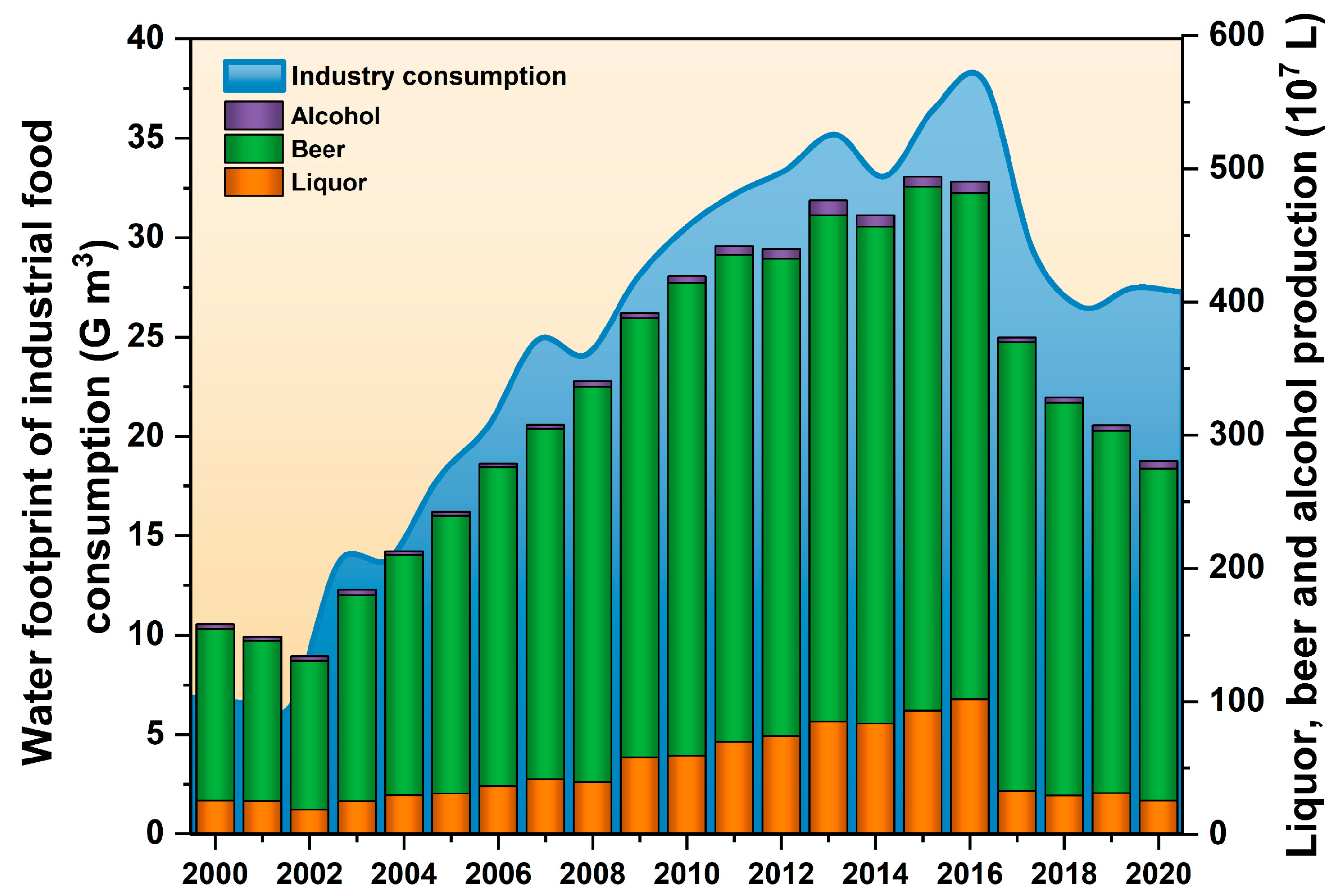

| Rank | C | Water-Resource Utilization Degree | Water-Resource Development Potential |
|---|---|---|---|
| Ⅰ | ≥10 | Very high | Bare |
| Ⅱ | [5, 10) | High | Small |
| Ⅲ | [2, 5) | Medium | Medium |
| Ⅳ | [1, 2) | Relatively low | Relatively large |
| Ⅴ | [0, 1) | Low | Great |
| Year | Population (Million) | Urbanization (%) | Grain-Consumption Water Footprint (billion m3) |
|---|---|---|---|
| 2025 | 173.1 | 59.5 | 155.2 |
| 2030 | 175.8 | 65.5 | 163.8 |
| 2035 | 177.8 | 67.8 | 171.8 |
| 2040 | 178.6 | 70.2 | 178.9 |
| 2045 | 178.8 | 72.5 | 185.8 |
| 2050 | 178.5 | 74.8 | 192.4 |
Publisher’s Note: MDPI stays neutral with regard to jurisdictional claims in published maps and institutional affiliations. |
© 2022 by the authors. Licensee MDPI, Basel, Switzerland. This article is an open access article distributed under the terms and conditions of the Creative Commons Attribution (CC BY) license (https://creativecommons.org/licenses/by/4.0/).
Share and Cite
Liu, X.; Xu, Y.; Sun, S.; Zhao, X.; Wang, Y. Analysis of the Coupling Characteristics of Water Resources and Food Security: The Case of Northwest China. Agriculture 2022, 12, 1114. https://doi.org/10.3390/agriculture12081114
Liu X, Xu Y, Sun S, Zhao X, Wang Y. Analysis of the Coupling Characteristics of Water Resources and Food Security: The Case of Northwest China. Agriculture. 2022; 12(8):1114. https://doi.org/10.3390/agriculture12081114
Chicago/Turabian StyleLiu, Xian, Yueyue Xu, Shikun Sun, Xining Zhao, and Yubao Wang. 2022. "Analysis of the Coupling Characteristics of Water Resources and Food Security: The Case of Northwest China" Agriculture 12, no. 8: 1114. https://doi.org/10.3390/agriculture12081114
APA StyleLiu, X., Xu, Y., Sun, S., Zhao, X., & Wang, Y. (2022). Analysis of the Coupling Characteristics of Water Resources and Food Security: The Case of Northwest China. Agriculture, 12(8), 1114. https://doi.org/10.3390/agriculture12081114





